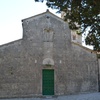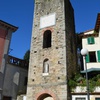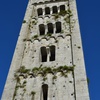Parish Church of S. Maria Assunta (Diecimo)
The parish church of Santa Maria Assunta is located south of the town of Diecimo, near the confluence of the Pedogna and Serchio rivers.
Formerly also dedicated to San Gervasio, it is one of the few churches that have maintained its original medieval structure over the centuries, a basilica divided into three naves by two sets of pillars decorated with alternating black and white marble.
The facade consists of a single portal surmounted by a double lancet window and a lintel relief decorated with plant shoots and human figures attributable to Biduino (12th century).
The semi-circular apse is decorated with blind arches and corbels with three large openings. In the apse, detached from the rest of the structure, stands a bell tower built in the Lombard Romanesque style.
To be found inside the church are numerous remains of medieval sculpture such as the baptismal font and, once belonging to a pulpit, two beautiful lions, one portrayed in the act of fighting a man armed with a knife and the other a dragon.
Also of note is a curious relief depicting a small-headed knight, commonly called “King Pipino”, armed with a shield and a spear.
In the village square you can find the Castruccio tower and the birthplace of San Giovanni Leonardi.
Historical notes
As a "loco", or locality, Diecimo was documented from 784. However, the parish was mentioned for the first time in 919, when the Bishop of Lucca, Pietro, gave the cleric Ghisalmari two churches that existed then in Anchiano, those dedicated to San Quirico and St. John, specifying in the act that together with these places of worship also to be awarded were the tithes of the parish of Santa Maria. A document preserved in the archives of Borgo di Mozzano tells the story of how this building was once fortified. A map dated 1590, indeed, shows the church with a tall bell-tower for issuing distress messages and another tower with battlements, corbels and loopholes that allowed the installation of the military apparatus from the second half of the 14th century. Most likely there was originally also a defensive wall surrounding the parish and outbuildings.











